Analysis of Stress-Strain States in the Vicinity of Mining Excavations in a Rock Mass with Variable Mechanical Properties
Abstract
1. Introduction
2. Analysis of the Variability of Rock and Rock Mass Properties in the Vicinity of Mining Excavations
- The values of strength and deformation properties of rocks in the rock mass can be determined on the basis of data from scattered points using statistical methods (Figure 3);
- The strength and deformation properties of the rocks surrounding the excavation may also change in time (e.g., as a result of mining works in the area of the excavation);
- For individual rock layers, no relationship was found between the change in the strength properties of the rocks and the depth of their deposition (Figure 4);
- The conducted statistical tests indicated that the strength and deformation properties of Carboniferous rocks can be treated as random variables with a normal probability distribution (Figure 1).
3. Construction of the Numerical Model
- In the first stage, the original stress state was determined in the model (modelled rock mass without excavation);
- In the second stage, the creation of the excavation was simulated by removing the elements inside its contour and introducing structural elements to the model, representing the arches of the steel supports.
4. Results of Conducted Numerical Simulations
4.1. Plasticisation Zones
4.2. Main Stress Distribution
4.3. Axial Forces in the Modelled Supports
5. Summary and Conclusions
- The actual occurrence of the variability of rock properties may have a significant impact on the conditions of the safe use of galleries;
- An increase in the variability coefficient with constant average values of material parameters increases the range of the plasticization zone in the vicinity of the excavation;
- The increase in the volume of plasticization zones with an increase in the variability coefficient from 0 to 20% is relatively small; however, at higher values, the number of plasticized elements in the model increases rapidly, and with the variability coefficient equal to 30%, the plasticization covers such a large part of the model (Figure 9f and Figure 10f) that it is impossible to balance it;
- Only the variability of strength parameters has a smaller impact on the state of the model than taking into account the variance of both strength and deformation parameters;
- Due to the variability of the strength parameters of the rock mass, elements that provide additional protection and reinforcement of the supports in the sections of increased support load in the form of beams, stands, multi-sided supports, or local anchoring of the rock mass become very significant;
- Numerical modelling of the rock mass, taking into account the variability of the material parameters of the rocks, allows for the mapping of the variability of the rock mass along the excavation and, by applying additional protection, for the improvement of the safety of excavation use.
Author Contributions
Funding
Conflicts of Interest
References
- Duży, S.; Szafulera, K. Przestrzenna losowa zmienność wytrzymałości na ściskanie piaskowców towarzyszących pokładom węgla kamiennego warstw orzeskich. Bud. Gór. Tunelowe 2007, 13, 20–24. [Google Scholar]
- Lu, J.; Huang, G.; Gao, H.; Li, X.; Zhang, D.; Yin, G. Mechanical Properties of Layered Composite Coal–Rock Subjected to True Triaxial Stress. Rock Mech. Rock Eng. 2020, 53, 4117–4138. [Google Scholar] [CrossRef]
- Małkowski, P.; Ostrowski, Ł.; Brodny, J. Analysis of Young’s modulus for Carboniferous sedimentary rocks and its relationship with uniaxial compressive strength using different methods of modulus determination. J. Sustain. Min. 2018, 17, 145–157. [Google Scholar] [CrossRef]
- Chudek, M. Zasady Doboru i Projektowania Obudowy Wyrobisk Korytarzowych i ich Połączeń w Zakładach Górniczych Wydobywających Wegiel Kamienny; KGBPiOP Wydz. Górnictwa i Geologii Politechniki Śląskiej: Gliwice, Poland, 2000. [Google Scholar]
- Hoek, E.; Brown, E.T. Practical estimates of Rock Mass Strength. Int. J. Rock Mech. Min. Sci. 1997, 34, 1165–1186. [Google Scholar] [CrossRef]
- Bukowski, P.; Bukowska, M. Changes of some of the mechanical properties of rocks and rock mass in conditions of mining exploitation and mine workings flooding. AGH J. Min. Geoeng. 2012, 36, 57–67. [Google Scholar]
- Brady, B.H.G.; Brown, E.T. Rock Mechanics for Underground Mining, 3rd ed.; Springer: Dordrecht, The Netherlands, 2006. [Google Scholar]
- Hoek, E.; Kaiser, P.K.; Bawden, W. Support. of Underground Excavations in Hard Rock; Balkema: Rotterdam, The Netherlands, 1995. [Google Scholar]
- Aladejare, A.E. Evaluation of empirical estimation of uniaxial compressive strength of rock using measurements from index and physical tests. J. Rock Mech. Geotech. Eng. 2020, 12, 256–268. [Google Scholar] [CrossRef]
- Mardalizad, A.; Scazzosi, R.; Manes, A.; Giglio, M. Testing and numerical simulation of a medium strength rock material under unconfined compression loading. J. Rock Mech. Geotech. Eng. 2018, 10, 197–211. [Google Scholar] [CrossRef]
- Pells, P.J.N. Unixial strength testing. Compr. Rock Eng. 1993, 3, 67–85. [Google Scholar]
- Rabat, Á.; Cano, M.; Tomás, R.; Tomayo, Á.; Alejano, L. Evaluation of Strength and Deformability of Soft Sedimentary Rocks in Dry and Saturated Conditions Through Needle Penetration and Point Load Tests: A Comparative Study. Rock Mech. Rock Eng. 2020, 53, 2707–2726. [Google Scholar] [CrossRef]
- Cai, M.; Kaiser, P.K. In-situ Rock Spalling Strength near Excavation Boundaries. Rock Mech. Rock Eng. 2014, 47, 659–675. [Google Scholar] [CrossRef]
- Duży, S.; Cholewa, M. Assessment of the risk of loss of stability of the steel arch support of the underground excavations. In Proceedings of the Mining of Sustainable Development Conference 2018, Gliwice, Poland, 28 November 2018; Jonczy, I., Komorek, J., Eds.; Institute of Physics: Bristol, UK, 2019. [Google Scholar] [CrossRef]
- Villaescusa, E.; Brown, E.T. Maximum likelihood estimation of joint size from trace length measurements. Rock Mech. Rock Eng. 1992, 25, 67–87. [Google Scholar] [CrossRef]
- Perras, M.; Diederichs, M. Predicting excavation damage zone depths in brittle rocks. J. Rock Mech. Geotech. Eng. 2016, 8, 60–74. [Google Scholar] [CrossRef]
- Tao, M.; Hong, Z.; Peng, K.; Sun, P.; Cao, M.; Du, K. Evaluation of Excavation-Damaged Zone around Underground Tunnels by Theoretical Calculation and Field Test Methods. Energies 2019, 12, 1682. [Google Scholar] [CrossRef]
- Wang, H.W.; Jiang, Y.D.; Xue, S.; Shen, B.T.; Wang, C.; Lv, J.G.; Yang, T. Assessment of excavation damaged zone around roadways under dynamic pressure induced by an active mining process. Int. J. Rock Mech. Min. Sci. 2015, 77, 265–277. [Google Scholar] [CrossRef]
- Souley, M.; Renaud, V.; Al Heib, M.; Bouffier, C.; Lahaie, F.; Nyström, A. Numerical investigation of the development of the excavation damaged zone around a deep polymetallic ore mine. Int. J. Rock Mech. Min. Sci. 2018, 106, 165–175. [Google Scholar] [CrossRef]
- Yang, H.Q.; Zeng, Y.Y.; Lan, Y.F.; Zhou, X.P. Analysis of the excavation damaged zone around a tunnel accounting for geostress and unloading. Int. J. Rock Mech. Min. Sci. 2014, 69, 59–66. [Google Scholar] [CrossRef]
- Martin, C.; Kaiser, P.; McCreath, D. Hoek–Brown parameters for predicting the depth of brittle failure around tunnels. Can. Geotech. J. 1999, 36, 136–151. [Google Scholar] [CrossRef]
- Perras, M.; Langford, C.; Ghazvinian, E.; Diederichs, M. Numerical delineation of the excavation damage zones: From rock properties to statistical distribution of the dimensions. In Proceedings of the ISRM International Symposium-EUROCK, Stockholm, Sweden, 28–30 May 2012. [Google Scholar]
- Shadabfar, M.; Huang, H.; Kordestani, H.; Muho, E.V. Probabilistic modeling of excavation-induced damage depth around rock-excavated tunnels. Results Eng. 2020, 5, 100075. [Google Scholar] [CrossRef]
- Cai, M. Rock Mass Characterization and Rock Property Variability Considerations for Tunnel and Cavern Design. Rock Mech. Rock Eng. 2011, 44, 379–399. [Google Scholar] [CrossRef]
- Jiang, S.H. Modelling of spatial variability of soil undrained shear strength by conditional random fields for slope reliability analysis. Appl. Math. Model. 2018, 63, 374–389. [Google Scholar] [CrossRef]
- Dyson, A.P.; Tolooiyan, A. Prediction and classification for finite element slope stability analysis by random field comparison. Comput. Geotech. 2019, 109, 117–129. [Google Scholar] [CrossRef]
- Yu, X.; Cheng, J.; Cao, C.; Li, E.; Feng, J. Probabilistic Analysis of Tunnel Liner Performance Using Random Field Theory. Adv. Civ. Eng. 2019, 2019, 1348767. [Google Scholar] [CrossRef]
- Fenton, G.A.; Gryffith, D.V. Probabilistic foundation settlement on spatially random soil. J. Geotech. Geoenviron. 2002, 128, 381–390. [Google Scholar] [CrossRef]
- Green, D.K.E.; Douglas, K.; Mostyn, G. The simulation and discretisation of random fields for probabilistic finite element analysis of soils using meshes of arbitrary triangular elements. Comput. Geotech. 2015, 68, 91–108. [Google Scholar] [CrossRef]
- Villaescusa, E.; Thompson, A.; Windsor, C. Probabilistic estimate of rock mass static and dynamic demands for underground excavation stabilisation. Rock Mech. Rock Eng. 2019, 11, 481–493. [Google Scholar] [CrossRef]
- Hudson, J.A.; Priest, S.D. Discontinuities and rock mass geometry. Int. J. Rock Mech. Min. Sci. Geomech. Abstr. 1979, 16, 339–362. [Google Scholar] [CrossRef]
- Duży, S. Studium niezawodności konstrukcji obudowy i stateczności wyrobisk korytarzowych w kopniach węgla kamiennego z uwzględnieniem niepewności informacji. Zesz. Nauk. Górnictwo/Politech. Śląska 2007, 277, 134–150. [Google Scholar]
- Kim, K.; Gao, H. Probabilistic approaches to estimating variation in the mechanical properties of rock masses. Int. J. Rock Mech. Min. Sci. Geomech. Abstr. 1995, 32, 111–120. [Google Scholar] [CrossRef]
- Vanmarcke, E.H. Probabilistic modeling of soil profiles. J. Geotech. Eng. Div. 1977, 103, 1227–1246. [Google Scholar]
- Karakus, M.; Tutmez, B. Fuzzy and multiple regression modeling for evaluation of intact rock strength based on point load, Schmidt hammer and sonic velocity. Rock Mech. Rock Eng. 2006, 39, 45–57. [Google Scholar] [CrossRef]
- Duży, S. Wpływ głębokości lokalizacji wyrobisk górniczych na niezawodność i bezpieczeństwo ich konstrukcji. Zagrożenia naturalne w górnictwie. In Proceedings of the XI Warsztaty Górnicze, Ślesin k, Konina, Poland, 4–6 June 2007; Pilecka, J., Ed.; Wyd. IGSMiE PAN: Kraków, Poland, 2007; pp. 183–196. [Google Scholar]
- Chen, D.; Xu, D.; Ren, G.; Jiang, Q.; Liu, G.F.; Wan, L.; Liu, Z. Simulation of cross-correlated non-Gaussian random fields for layered rock. Comput. Geotech. 2019, 112, 104–119. [Google Scholar] [CrossRef]
- Exadaktylos, G.; Stavropoulou, M. A specific upscaling theory of rock mass parameters exhibiting spatial variability: Analytical relations and computational scheme. Int. J. Rock Mech. Min. Sci. 2008, 45, 1102–1125. [Google Scholar] [CrossRef]
- Stavropoulou, M.; Exadaktylos, G.; Saratsis, G. Combined three-dimensional geological-geostatistical-numerical model of underground excavations in rock. Rock Mech. Rock Eng. 2007, 40, 213–243. [Google Scholar] [CrossRef]
- Fast Lagrangian Analysis of Continua in 3 Dimensions, User Manual; Itasca Consulting Group: Minneapolis, MN, USA, 2009.
- Hang Lin, H.; Taoying Liu, T.; Li, J.; Cao, P. A Simple Generation Technique of Complex Geotechnical Computational Model. Math. Probl. Eng. 2013, 2013, 863104. [Google Scholar] [CrossRef]
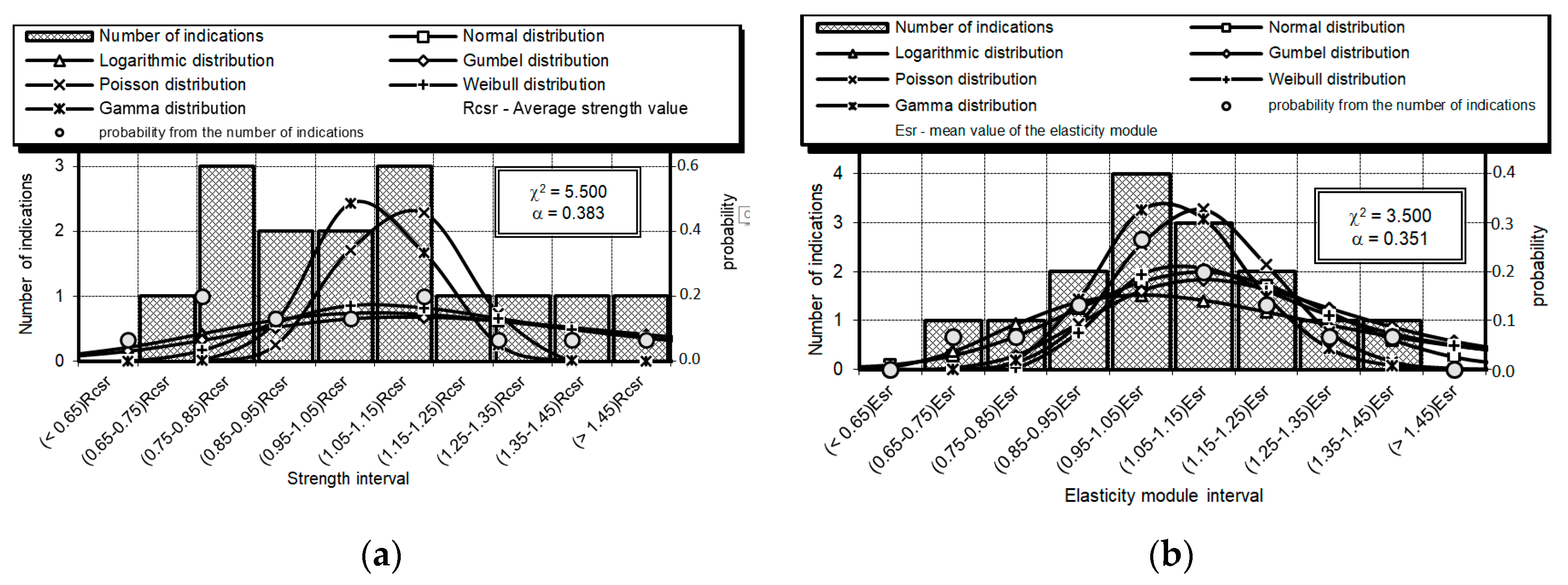
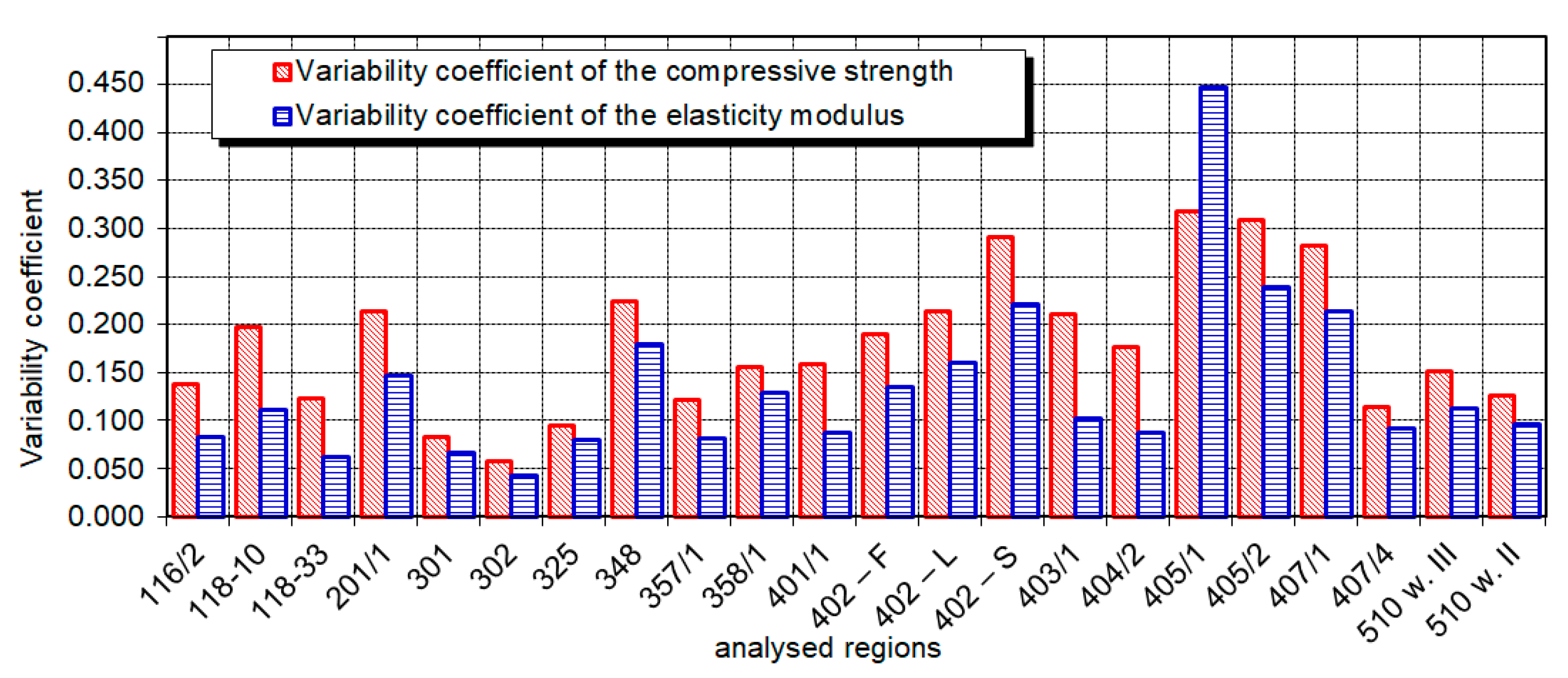
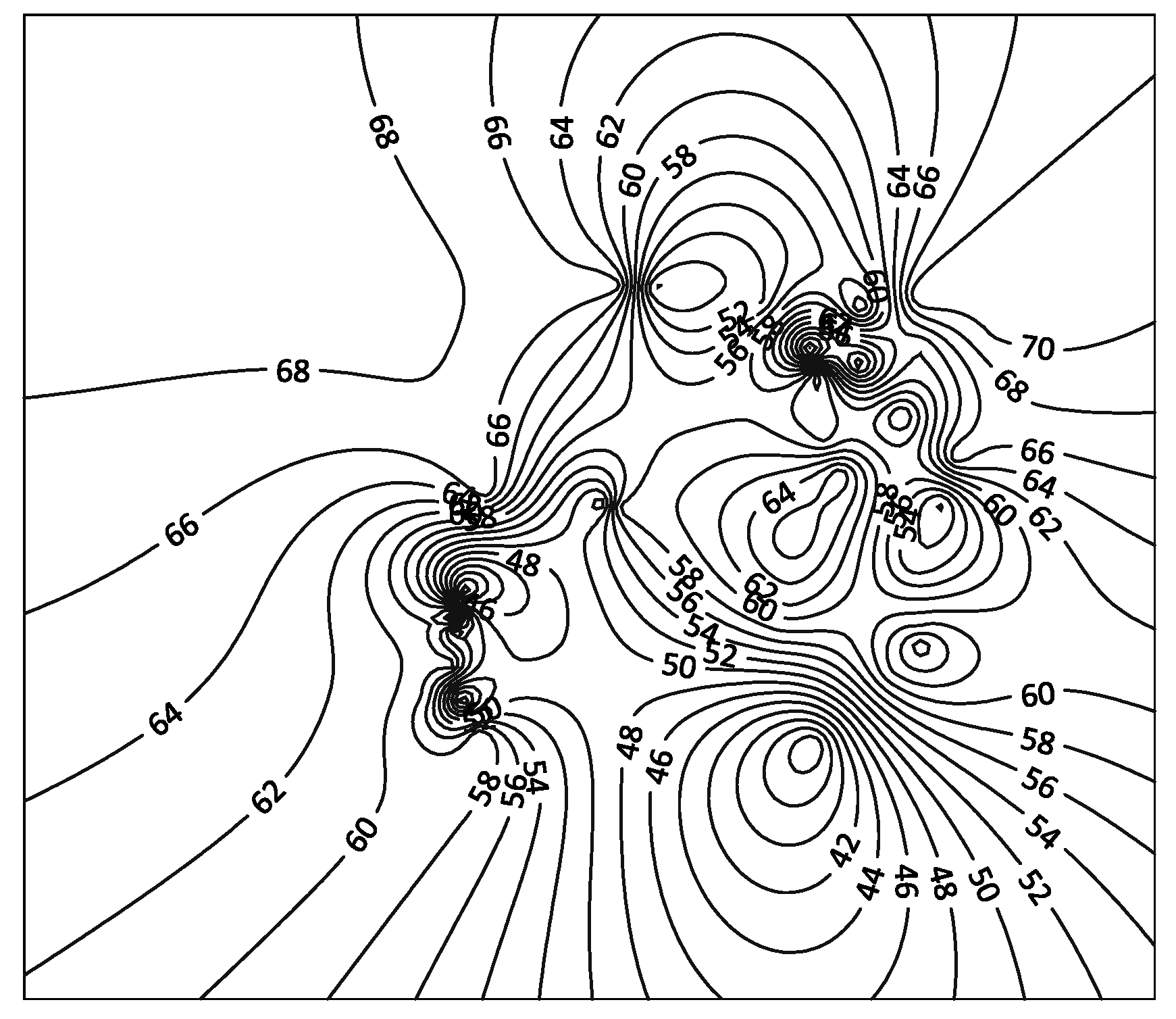

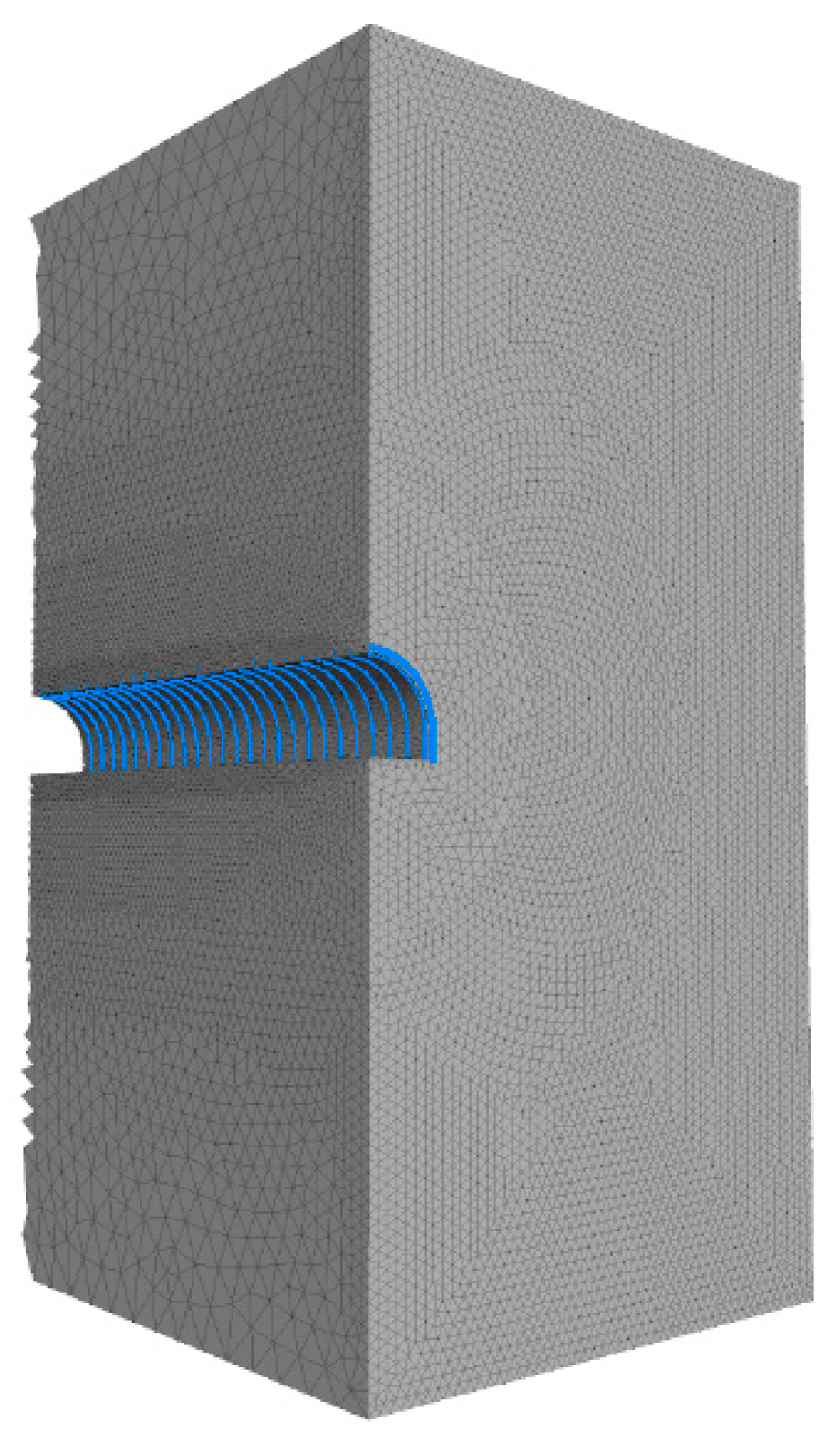
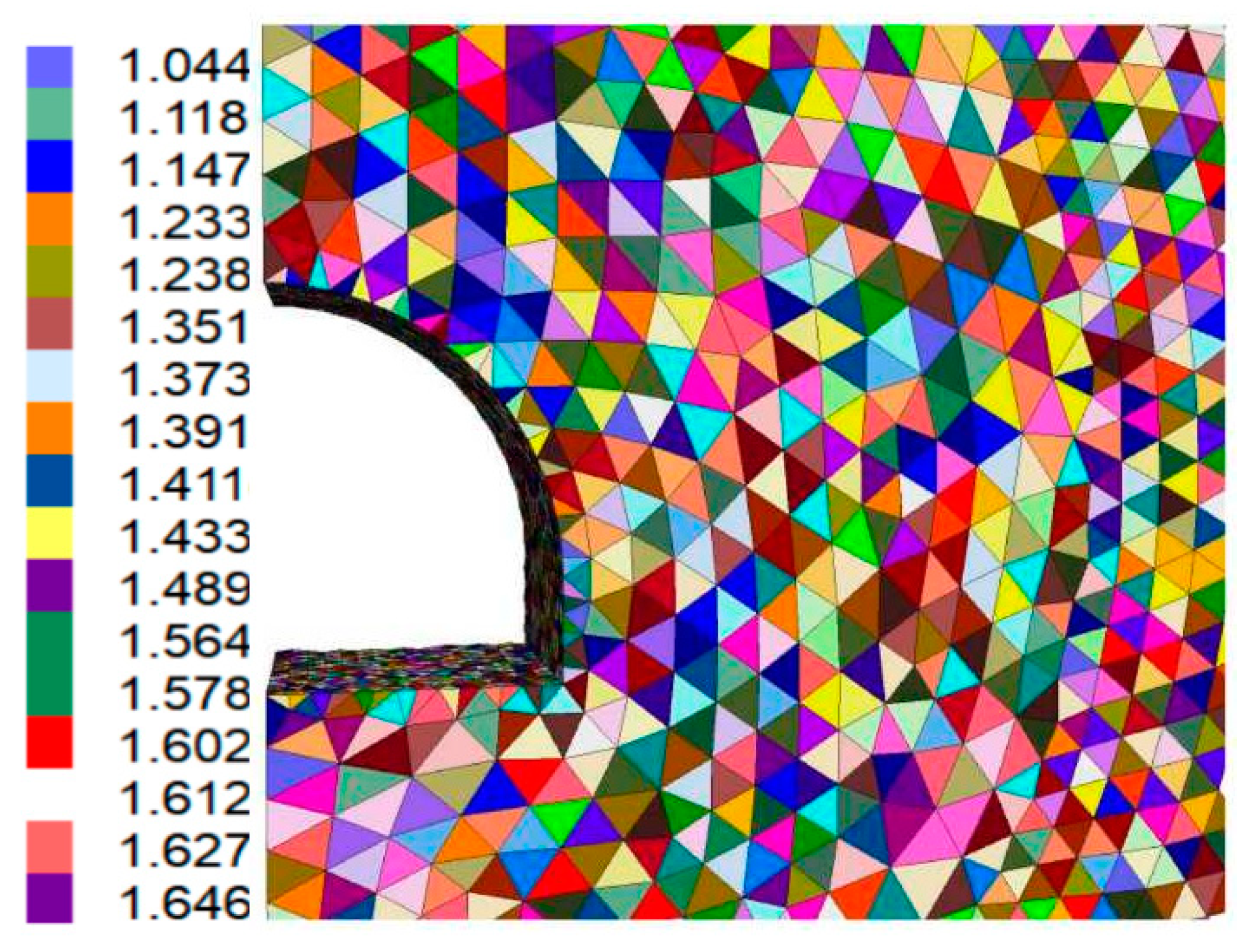
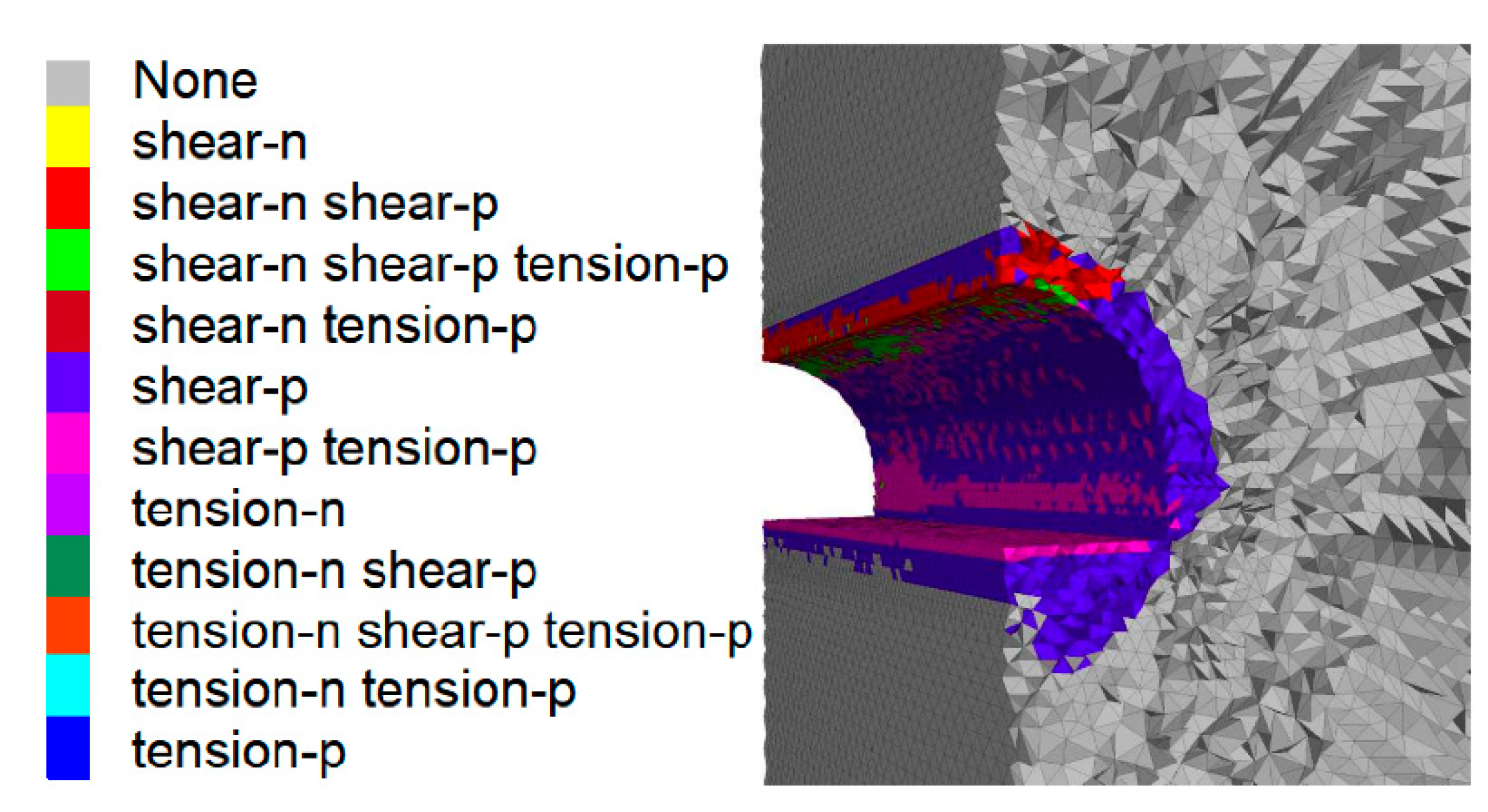
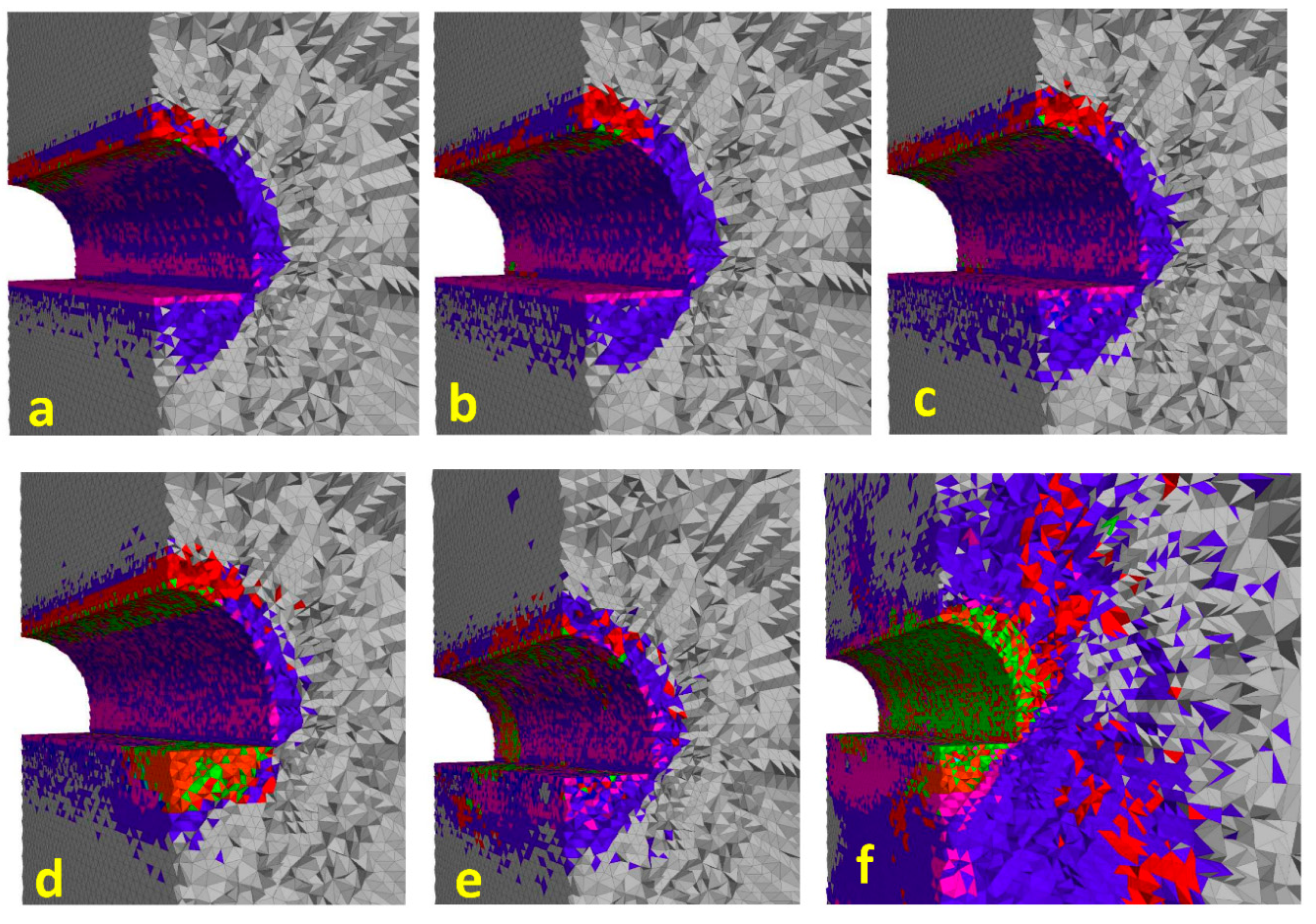

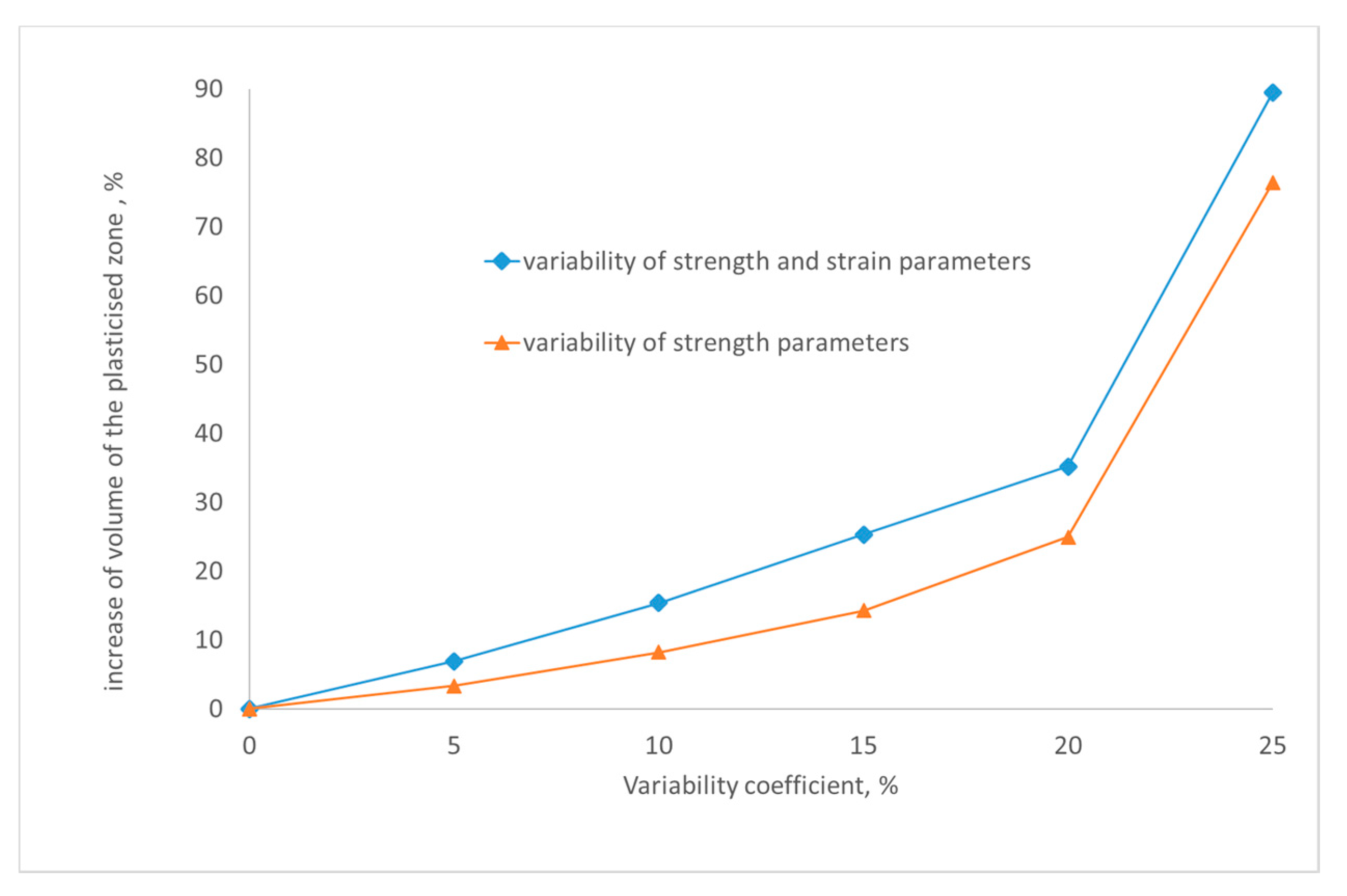

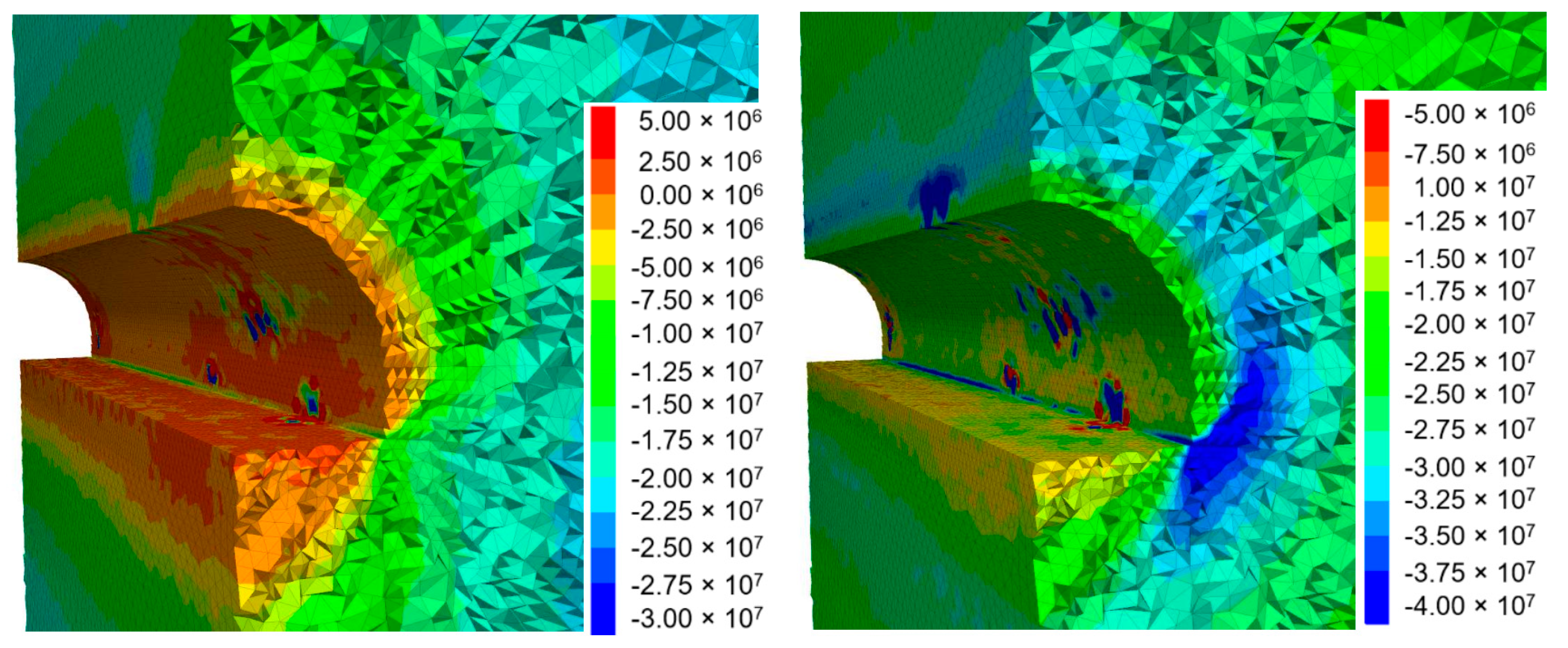
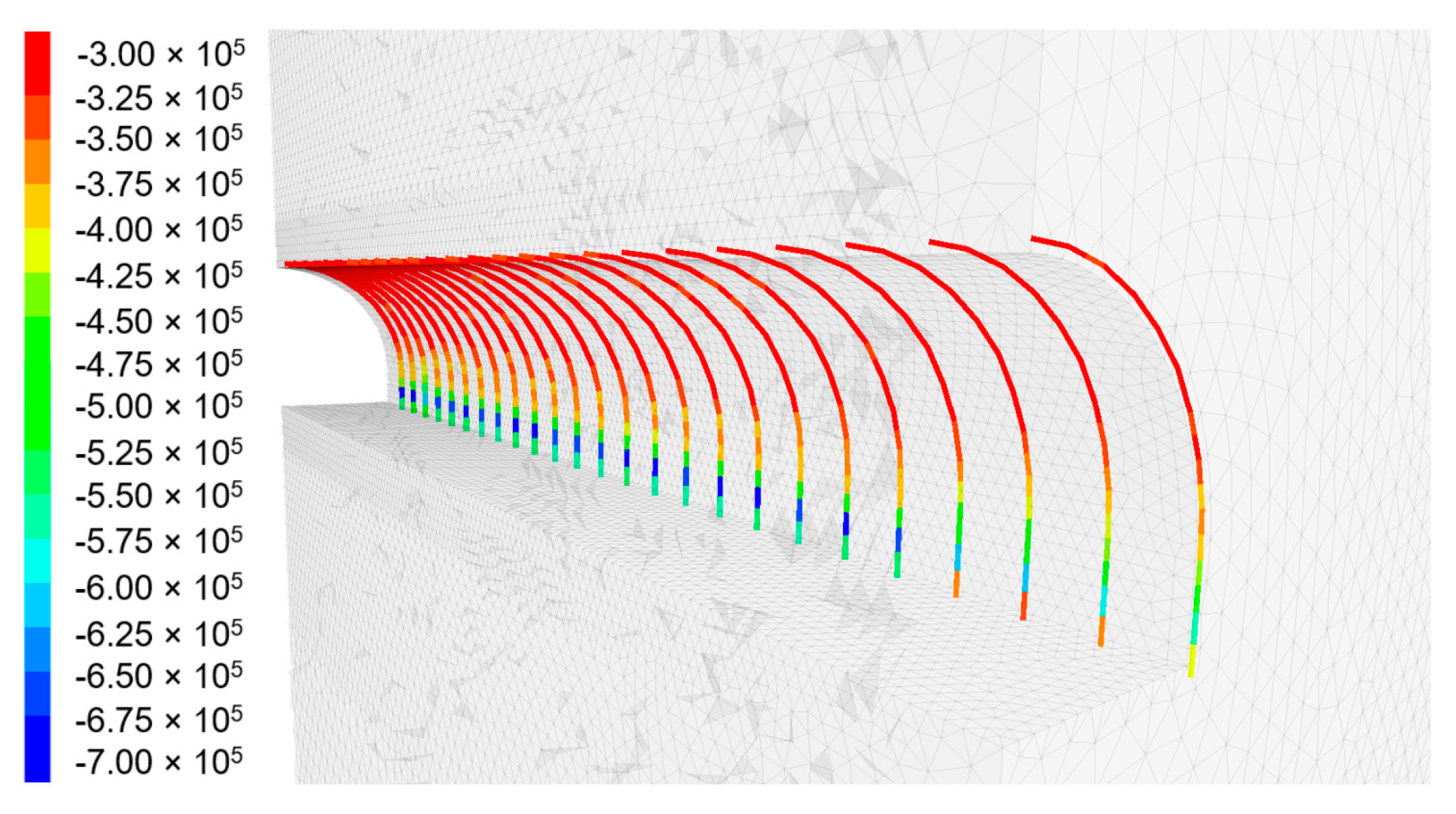
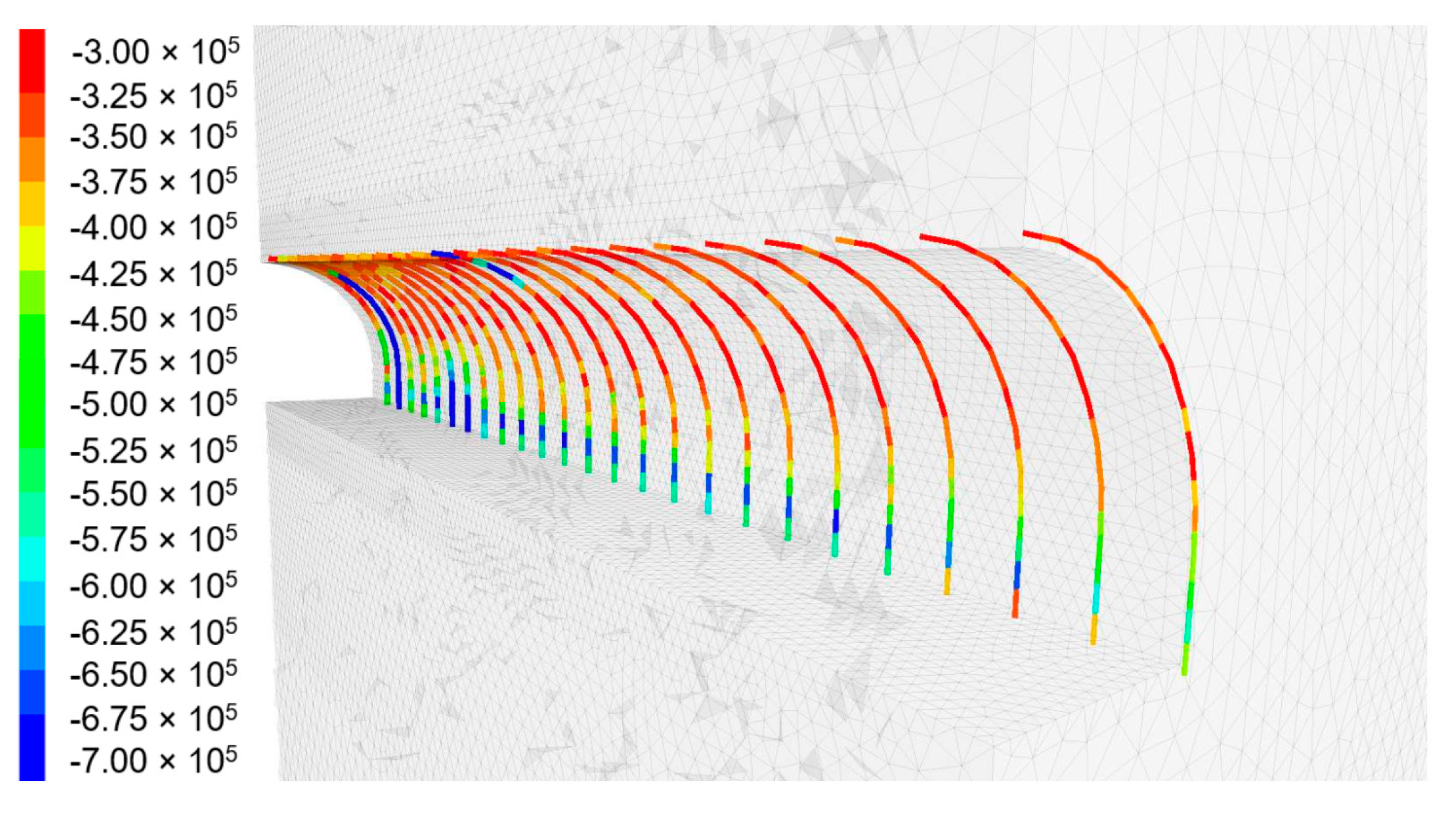

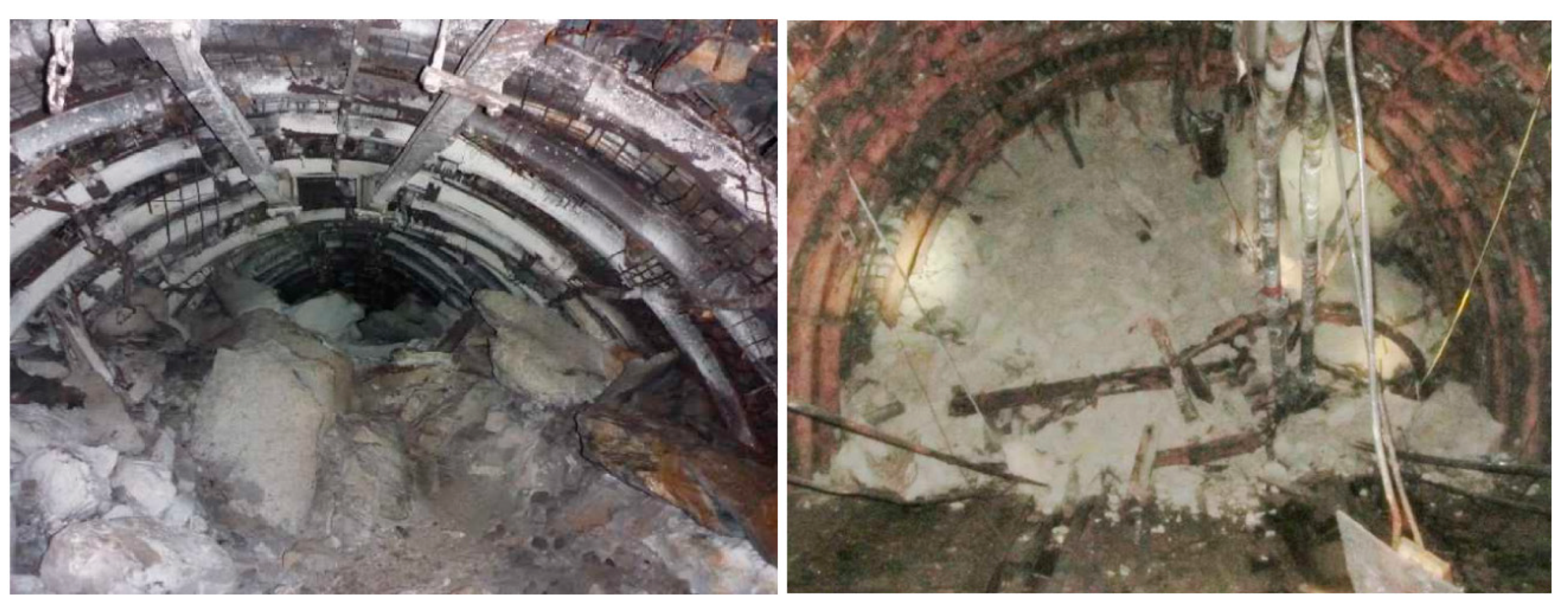
| Variant | Variability Coefficient | Volumetric Elasticity Coefficient | Shear Elasticity Coefficient | Cohesion | Internal Friction Angle | Tensile Strength |
|---|---|---|---|---|---|---|
| % | GPa | GPa | MPa | ° | MPa | |
| average value | ||||||
| 2.38 | 2.17 | 5 | 30 | 1 | ||
| standard deviation | ||||||
| 0 | 0 | 0 | 0 | 0 | 0 | 0 |
| Ia | 5 | 0 | 0 | 0.25 | 1.5 | 0.05 |
| Ib | 10 | 0 | 0 | 0.5 | 3 | 0.1 |
| Ic | 15 | 0 | 0 | 0.75 | 4.5 | 0.15 |
| Id | 20 | 0 | 0 | 1 | 6 | 0.2 |
| Ie | 25 | 0 | 0 | 1.25 | 7.5 | 0.25 |
| If | 30 | 0 | 0 | 1.5 | 9 | 0.3 |
| IIa | 5 | 0.12 | 0.11 | 0.25 | 1.5 | 0.05 |
| IIb | 10 | 0.24 | 0.22 | 0.5 | 3 | 0.1 |
| IIc | 15 | 0.36 | 0.33 | 0.75 | 4.5 | 0.15 |
| IId | 20 | 0.48 | 0.43 | 1 | 6 | 0.2 |
| IIe | 25 | 0.6 | 0.54 | 1.25 | 7.5 | 0.25 |
| IIf | 30 | 0.71 | 0.65 | 1.5 | 9 | 0.3 |
Publisher’s Note: MDPI stays neutral with regard to jurisdictional claims in published maps and institutional affiliations. |
© 2020 by the authors. Licensee MDPI, Basel, Switzerland. This article is an open access article distributed under the terms and conditions of the Creative Commons Attribution (CC BY) license (http://creativecommons.org/licenses/by/4.0/).
Share and Cite
Jendryś, M.; Duży, S.; Dyduch, G. Analysis of Stress-Strain States in the Vicinity of Mining Excavations in a Rock Mass with Variable Mechanical Properties. Energies 2020, 13, 5567. https://doi.org/10.3390/en13215567
Jendryś M, Duży S, Dyduch G. Analysis of Stress-Strain States in the Vicinity of Mining Excavations in a Rock Mass with Variable Mechanical Properties. Energies. 2020; 13(21):5567. https://doi.org/10.3390/en13215567
Chicago/Turabian StyleJendryś, Marek, Stanisław Duży, and Grzegorz Dyduch. 2020. "Analysis of Stress-Strain States in the Vicinity of Mining Excavations in a Rock Mass with Variable Mechanical Properties" Energies 13, no. 21: 5567. https://doi.org/10.3390/en13215567
APA StyleJendryś, M., Duży, S., & Dyduch, G. (2020). Analysis of Stress-Strain States in the Vicinity of Mining Excavations in a Rock Mass with Variable Mechanical Properties. Energies, 13(21), 5567. https://doi.org/10.3390/en13215567







